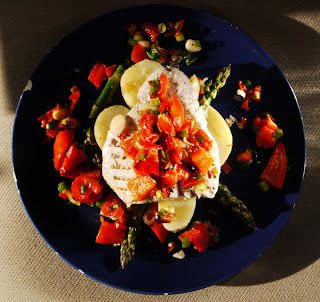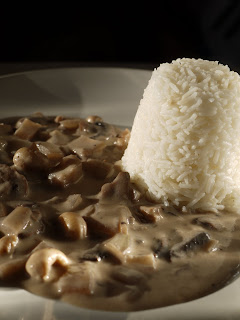With an evening confirmed, I scoured my recipe notebook. It keeps all of my tried, tested and approved hand-written recipes as well as being stuffed with a massive collection of recipes torn from magazines and notes jotted down on paper. I (in true Come Dine with Me style) was in the mood to try something new.
Our starter was based on a Hoisin and Apricot glazed prawn recipe by the Greedy Gourmet. Having made this decision, I then had to find raw, shell-on prawns. Cooked shell-on prawns, no problem. Raw, shelled prawnies, easy-peasy. Eventually, we got them at short notice from Rock Fish in Bristol when we were passing by. I suppose we could've ordered them in from a fishmonger but our dinner was a relatively spontaneous affair. They were absolute monsters! Humungous!!
A quicker, easier and safer way to prepare shell-on prawns
When it came to preparing them, Greedy Gourmet suggested cutting through the back of each prawn with a knife but I found this to be far too fiddly - I couldn't get any grip on the knifes blade and everytime I tried to cut, the knife would slip against the shell which seemed like a recipe for nasty cuts. Instead, I took to cutting them with a pair of poultry scissors before dissecting them with a knife. The original recipe suggested using the grill but I was lucky enough to have The Boy on barbecue duty which was fantastic!
Barbecued Hoisin & Apricot glazed prawns with stir-fry
Serves 6 as a starter
Apologies for the slap-dash photography - this was taken in the seconds before these beauties went to the table with no time to 'style' them up.
12 raw shell-on tiger prawns
1 tbsp sesame seeds
1 tin of apricot halves in juice
2 tbsp soy sauce
100g bean sprouts
100g cabbage or spring greens, finely chopped
1 bok choi, finely sliced
2 peppers, deseeded and sliced
2 tbsp sesame oil
For the marinade:
2 tbsp olive or ground nut oil
2 garlic cloves, crushed
2 tsp grated ginger
2 tbsp soy sauce
125ml hoisin sauce
125ml apricot jam
- With scissors, snip down back of each prawn then score through the flesh with a knife. About 5mm down, you'll find a thin, dark digestive tract surrounded by dark cushiony flesh. Remove this carefully with a knife - carefully slice the top near the head and gently pull down to the tail. Rinse the prawns with plenty of running water and pat dry with paper towel. Put the prawns in a large bowl and prepare the marinade.
- Heat oil in a saucepan over medium heat and fry the garlic and ginger for 2 minutes. Stir in the apricot jam, soy and hoisin sauce. Bring to a simmer then leave to cool.
- Once cooled, pour over the prawns and leave to marinate for up to 4 hours.
- Before serving, prepare your barbecue and bring it up to heat.
- Drain the apricots and reserve the juice.
- Scatter the sesame seeds into a saucepan and place them over a medium heat to toast. Keep an eye on them and stir regularly to prevent them burning. When they turn golden brown, they're ready.
- Meanwhile, heat the sesame oil in a wok over a high heat. Add the bean sprouts, cabbage, bok choi and peppers and stir fry for a few minutes. Add the soy and 2 tbsp of the apricot juice.
- Barbecue for 6 - 8 minutes (ideally get your glamourous assistant - in my case, The Boy - to do this while you're stir frying) until the flesh of the prawns are opaque all the way through and the outside is slightly charred. Pop the apricots on the grill too for a minute or so on each side until caramalised.
- To serve, place two prawns on each plate on a bed of stir-fry vegetables and apricots, sprinkled with toasted sesame seeds.
What a treat! They were finger-lickingly sticky with the soy and hoisin. Be sure to put paper towels on the table and a finger bowl or two as they can be a bit messy. You'll be wanting a pot to put the discarded prawn shells in too! I found that it was cheaper by volume to buy a little pouch of hoisin which was meant for stirfrys or one-off meals than to buy a bottle of hoisin sauce.
Our main came in the form of an interesting looking steak salad by the lovely Hugh Fernley-Whittingstall. I've been wanting to try it for ages and this seemed like the opportune moment to give it a go as we had a ripe mango and avocado sat in our fruit bowl. The steak was sourced from a fantastic butcher in Weston-super-mare which was very busy even though it was Saturday morning. It's always good to see an independant shop looking busy and is something that I look out for when I'm checking out a new shop - if other people want to buy from there then there's a good chance that it's good quality and worth trying.
Mango, avocado and steak salad
Serves 6 as a main course
Another super-quick snap before serving
For the marinade
2 cloves garlic, peeled and finely minced
1 tbsp oyster sauce (optional)
1 tbsp dry sherry
2 tsp soy sauce
1 tsp light muscovado sugar
1 tsp grated fresh ginger
A little black pepper
For the salad
350g sirloin steak
1 large, ripe mango
1 large, ripe avocado (or 2 smaller ones)
250g rocket leaves
250g edamame or soy beans
6 leaves of Chinese leaf, finely sliced
1 bunch of coriander, stalks finely chopped
1 red chilli, halved, deseeded and finely sliced
2 spring onions, topped and tailed
For the dressing
2 tbsp Thai fish sauce (or Worcestershire sauce)
1 tbsp sesame oil
Juice of 1 lime
1 tbsp soy sauce
1 tsp light muscovado sugar
1 clove garlic, peeled and finely minced
Salt and freshly ground black pepper
- Whisk together all the ingredients for the marinade.
- Add the steak and rub all over with the marinade until it is well coated. Leave to marinate for 30 minutes to an hour in an air tight box.
- While the meat is marinating, prepare the rest of the salad. Cut the mango away from the stone, lay the flat (cut) side on a chopping board or work surface and peel then cut into long, thin slices.
- Slice around the avocado until you hit the stone, twist and remove the stone. If your avocado is ripe enough, you should be able to gently remove theflesh from skin in one piece and slice into thin strips.
- Whisk together all of the ingredients for the dressing.
- Sear the steak on the barbecue for around four minutes on each side, depending on how well you want it to be cooked. You could also do this in a griddle or frying pan as Hugh suggests but I think that the good ol' bbq lends a lovely smokey flavour. The outside will char a little and ours was nicely pink and juicy inside. Leave to rest for a few minutes while you assemble the salad.
- Boil the edamame beans for five minutes or until bright green and tender then remove from the water. Add the spring onions to the pan and blanch for a minute then refresh in cold water. Slice thinly.
- Slice the steak as thinnly as possible and add any resting juices to the salad dressing.
- Plonk the salad leaves and edamame beans on one large platter. Arrange the steak, mango and avocado on top with trickle on the dressing and scatter over the coriander and chilli.
This went down very well with all of our guests and I think that this marinade could work really well for lots of meats. Delish! Since my foray into dinner parties, I found this awesome article by Rachel at What Rachel Ate. I wish that I'd had her guiding me through! A must-read for anyone who's hosting their first dinner or just wanting to update their table.



























